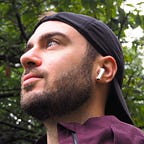Designing for Watch
One of the most important aspects of design is restraint. Designing for Watch is an exercise in extreme restraint. How so? According to Apple, a user should be able to complete their task in less than 2 seconds.
I’ve been using the Watch since it came out. Like most people, the main thing I use it for is fitness tracking. I’ve spent more time with the Workout app than all other watch apps combined. I have 2 problems with the Workout app:
- It doesn’t offer enough choice in workout types.
- It takes too long to start a workout.
When watchOS 3 opened up more fitness and workout features to developers, I knew I could implement my vision of a more flexible and more streamlined workout app. Let’s do a deep dive of the Workout app, see how Apple solved their design problems, and examine how my app — Sweaty Bird — improves upon it.
The Problem
HealthKit supports tracking over 70 different types of workouts and activities — everything ranging from cardio exercises like running and cycling, to sports and other activities such as weight lifting, yoga, etc.
This brings us to our main problem: how do we be flexible in allowing you to choose from all of these workouts, but keep the interaction time under 2 seconds? We can’t just display all 70 workouts in a table. We should at most display a few pages worth of data.
Apple’s Workout app
Apple approached this problem with a very Apple-y solution — by limiting your choices. They give you 9 different cardio workouts, and the “Other” activity type serves as a catch-all. If you want to record, for example, a strength training or basketball workout, you must first log it as an “Other” workout, then go back and recategorize it afterwards.
This solution succeeds in keeping the interaction time quick. But, as I previously wrote about, it’s a bit underwhelming. Besides my bike rides, my Health history is filled with “Other” workouts.
Identify Patterns
A very useful design tool is to identify patterns in user behavior. By identifying patterns, we can optimize our solution. It turns out that people exercise in very predictable patterns. Exercise routines are called routines, after all.
People don’t tend to do all 70 of these different workout types. The majority of people will use around 20 or less of these workouts. To narrow our list down, we can simply ask the user to personalize their workout list. When you first install Sweaty Bird, you choose which workouts will appear on your watch. With that simple feature, we’ve now significantly trimmed the list down from 70+ workouts to around 10–20. To start a workout, the user has to:
- Open the app
- Scroll through a list to find their workout
- Tap the workout
We’re pretty close to 2 seconds, but how do we make this even faster?
Location
Looking at workout patterns more, it’s obvious that people mostly do certain workouts at specific locations. When you’re at the gym, you may alternate between strength training, indoor running, and high intensity interval training. When you’re at the yoga studio, if you’re like me, you alternate between yoga and hunting for Pokemon.
When you’re at these places, why don’t we only show you the workouts that you care about? By having the user assign their workouts to locations, we can make the workout list adjust itself depending on where you are.
By taking the user’s location into account, we’ve now trimmed the list down from 10–20 workouts to only about 1–4 at a time — enough to fit on a single page! The steps to start a workout are now just:
- Open the app
- Tap the workout
Since you no longer have to scroll, the interaction time is less than 2 seconds. But let’s not stop there. We have to ask one more time — can we make this even faster?
Notifications
We now know your common workout spots. Therefore, we can present you with a notification when you arrive at one of these locations. The notification has quick action buttons that allow you to start a workout without even opening the app!
Not only do these notifications provide a speed boost, but they are useful in other ways. Sometimes you forget to start or stop tracking your workout. When we detect that you leave your workout region, if you have a (non-outdoor) workout still running, you’ll get a notification asking if you meant to stop tracking.
Summary
By framing our problem, and designing around our constraints, we were able to create a solution that is both faster and more flexible than the default Workout app. While Apple’s approach requires no setup, it is inflexible. My approach requires initial setup by the user, but then they have a personalized workout list that adjusts to their habits.
Sweaty Bird is available now in the App Store.
Stay sweaty, my friends!
Thank you for reading! If you like this article, please take a moment to click the Share or Recommend button so more people will be able to read it.
You may also like some of my other stories.
Lastly, you can follow me on Twitter, where I talk alot about iOS design & development.
